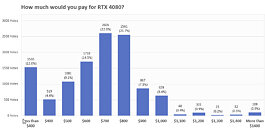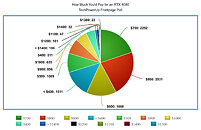- Joined
- Oct 9, 2007
- Messages
- 47,599 (7.45/day)
- Location
- Dublin, Ireland
| System Name | RBMK-1000 |
|---|---|
| Processor | AMD Ryzen 7 5700G |
| Motherboard | Gigabyte B550 AORUS Elite V2 |
| Cooling | DeepCool Gammax L240 V2 |
| Memory | 2x 16GB DDR4-3200 |
| Video Card(s) | Galax RTX 4070 Ti EX |
| Storage | Samsung 990 1TB |
| Display(s) | BenQ 1440p 60 Hz 27-inch |
| Case | Corsair Carbide 100R |
| Audio Device(s) | ASUS SupremeFX S1220A |
| Power Supply | Cooler Master MWE Gold 650W |
| Mouse | ASUS ROG Strix Impact |
| Keyboard | Gamdias Hermes E2 |
| Software | Windows 11 Pro |
The ideal price for the NVIDIA GeForce RTX 4080 "Ada" graphics card is around USD $700 to $800, according to results from a recent TechPowerUp Front-page poll surveying our readers. Our poll "How much would you pay for RTX 4080 at most?" received over 11,000 responses. At the number 1 spot with 22% of the vote is $800, closely followed by $700. Together, this range represents 44% of the voters. 14% of our readers think $600 is an ideal price, followed by "less than $400" at 13%. 9% think $500 seems fair, followed by 7% willing to spend as much as $900. 5% is happy to spend $1,100. 2% or less feel that the current $1,200 MSRP is justified or are willing to spend more than MSRP. There's more to a majority finding sanity with the $700 to $800 price-range.
With NVIDIA cancelling the RTX 4080 12 GB, the RTX 4080 16 GB became the only SKU to bear the name "RTX 4080." This $1,200 MSRP GeForce RTX 4080 is the successor to the RTX 3080, which debuted at $700, marking a $500 MSRP increase generation-over-generation (or +71%). You begin to see why most readers prefer the $700-800 range to be the ideal MSRP, and are willing to tolerate a $100 increase. For even more context, the RTX 3080 "Ampere" launched at the same $700 MSRP that its successor, the RTX 2080 "Turing" launched at. The GTX 1080 "Pascal" came out at $600 ($700 for the Founders Edition), which explains the interest for $600 in our poll.

And then there's a sizable chunk of our readers who simply seem disillusioned with GPU pricing, and feel that either $500 to $400, or something lower, is the max that they would be willing to pay for the RTX 4080. Can NVIDIA even break-even at such prices? NVIDIA's own quarterly financial results reference vague margins as high as 60% (not specific to any product, but as a general rule, margins tend to be proportionate to MSRP, with the higher priced products generally having a fatter margin). At 50% to 60% margins for its $1,200 MSRP, we'd be in the neighborhood of $500 to $600. We've seen examples in the past of NVIDIA cutting its prices in sharp response to competitive AMD products, with both brands fiercely locked in price-wars, and their products selling at less than half their MSRPs. So a $500 to $600 price for the RTX 4080 still seems possible on paper, and cannot be easily dismissed as "impossible."
On the other hand, prices have been going up everywhere: we've got inflation, higher prices for gas and power, and no doubt, TSMC is charging more for a 4 nm wafer than what Samsung has been charging for their 8 nm technology. NVIDIA was also Samsung's biggest customer—today there's plenty of competition for allocation on TSMC's latest and greatest nodes. Apple, Qualcomm, AMD, everybody wants their chips made on the best process in the world, so prices will end up higher for that reason, too.

A tiny fraction of our readers thinks that the $1,200 MSRP is fair, or is willing to pay more than $1,400. This probably aligns with the demographic that is actually buying the RTX 4080 at its current prices—or are willing to spend top-dollar for any other high-end graphics card. The poll results indicate that NVIDIA will be able to push more volume by lowering the price, but given the current inventory levels of GeForce 30 cards it could be that they rather be content selling the RTX 4080 at ≥$1,200 at high margins to a tiny fraction of people.
View at TechPowerUp Main Site
With NVIDIA cancelling the RTX 4080 12 GB, the RTX 4080 16 GB became the only SKU to bear the name "RTX 4080." This $1,200 MSRP GeForce RTX 4080 is the successor to the RTX 3080, which debuted at $700, marking a $500 MSRP increase generation-over-generation (or +71%). You begin to see why most readers prefer the $700-800 range to be the ideal MSRP, and are willing to tolerate a $100 increase. For even more context, the RTX 3080 "Ampere" launched at the same $700 MSRP that its successor, the RTX 2080 "Turing" launched at. The GTX 1080 "Pascal" came out at $600 ($700 for the Founders Edition), which explains the interest for $600 in our poll.

And then there's a sizable chunk of our readers who simply seem disillusioned with GPU pricing, and feel that either $500 to $400, or something lower, is the max that they would be willing to pay for the RTX 4080. Can NVIDIA even break-even at such prices? NVIDIA's own quarterly financial results reference vague margins as high as 60% (not specific to any product, but as a general rule, margins tend to be proportionate to MSRP, with the higher priced products generally having a fatter margin). At 50% to 60% margins for its $1,200 MSRP, we'd be in the neighborhood of $500 to $600. We've seen examples in the past of NVIDIA cutting its prices in sharp response to competitive AMD products, with both brands fiercely locked in price-wars, and their products selling at less than half their MSRPs. So a $500 to $600 price for the RTX 4080 still seems possible on paper, and cannot be easily dismissed as "impossible."
On the other hand, prices have been going up everywhere: we've got inflation, higher prices for gas and power, and no doubt, TSMC is charging more for a 4 nm wafer than what Samsung has been charging for their 8 nm technology. NVIDIA was also Samsung's biggest customer—today there's plenty of competition for allocation on TSMC's latest and greatest nodes. Apple, Qualcomm, AMD, everybody wants their chips made on the best process in the world, so prices will end up higher for that reason, too.

A tiny fraction of our readers thinks that the $1,200 MSRP is fair, or is willing to pay more than $1,400. This probably aligns with the demographic that is actually buying the RTX 4080 at its current prices—or are willing to spend top-dollar for any other high-end graphics card. The poll results indicate that NVIDIA will be able to push more volume by lowering the price, but given the current inventory levels of GeForce 30 cards it could be that they rather be content selling the RTX 4080 at ≥$1,200 at high margins to a tiny fraction of people.
View at TechPowerUp Main Site





 .
.



